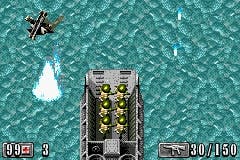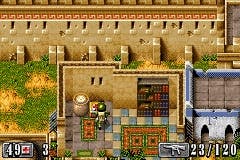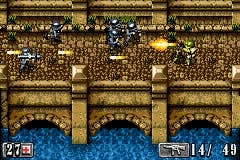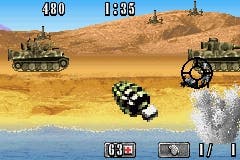Medal of Honor: Infiltrator
After Underground, we didn't expect much from this. Fools we were!
First-person shooters do not work on the Game Boy. There. I've said it. Yes, you can dial down the texture detail until the whole things looks like a Picasso, and sprites are clearly your best friend, but it's like playing DOOM using a keyboard on a 386. It's funny how people don't do that any more, isn't it?
Granted, if you absolutely cannot afford any other system besides a GBA, you could make plenty of excuses for the handheld DOOM twins and even Duke Nukem, but given that the Cube is cheaper than a GBA SP at the moment, that seems highly unlikely (and if it's too expensive then you've either got some stingy parents or you need to sue your 'better half' for false advertising). Anyway, you could always buy an N64 and GoldenEye for a tenner on eBay if you absolutely must have an FPS fix for next to nowt. Nope, I'm totally unconvinced by the handheld FPS.
So I'll be wearing a suitably smug grin later on, then, when I point out how well Medal of Honor works on the Game Boy using Netherock's top-down action game approach - compared, that is, to the irrepressibly drab and awful confines of Medal of Honor: Underground, a handheld first-person shooter that deserves to rot in the handheld bargain bin for all eternity (if such a thing existed).
Top down gun

Having abandoned the first-person viewpoint, Infiltrator is a much more straightforward game, with each of its 15 levels falling helpfully (for me) into one of three basic designs - all-out action, stealth missions and Operation Wolf-style shooting galleries. The action is shot from high above and behind the player, who can fire eight ways, strafe while holding the right trigger, commandeer the odd machine gun turret and vehicle with the left trigger, and switch between grenades/explosives and regular weapons using B.
Weapons are familiar, but obviously shot from above we're dealing with old school repeating bursts, which resemble the sort of gunfire you see in 2D shoot-'em-ups like Metal Slug. To add a bit of thought and strategy to the otherwise linear progression you're regularly given the chance to change your loadout in tents and munitions bunkers. Cleverly the loadouts consist of one weapon and either grenades, dynamite or a bazooka, but the more powerful your explosives, the more you sacrifice rate of fire or range with your main weapon. A Thompson SMG, for example, gets you a nice stock of grenades, but if you opt for the bazooka instead, you're limited to a pithy Colt 45 handgun. A nice balance.
Weapons and health can be reloaded and restocked thanks to power-ups strewn around each level or dropped by defeated enemy soldiers, or found in bunkers and buildings - revealed by a nice cutaway effect as you step inside. Although it's difficult to avoid detection in some of the latter stealth levels, resulting in crushing numbers of reinforcements sapping your bullets, generally speaking there's enough ammo and health to keep you going, and you have a decent stock of continues and generous respawn points should you actually come a cropper.
Acute Nazism

Gameplay itself falls, as I said, into three distinct styles, although action regularly spills into the stealth sections if you fail to remain undercover. Combat is a process of identifying where the bastards are, pointing roughly in that direction, clamping the right shoulder button and strafing them with gunfire. It's not all that troublesome, but sometimes the limited angles of the D-pad mean you'll find yourself getting hit a bit unfairly as you struggle to find a workable shooting angle, and there are certainly occasions when you feel an enemy is using an angle you wouldn't get away with.
As stealth becomes more significant, you'll quickly develop a more clandestine approach than the initial run-and-gun tactics, nipping in behind buildings and then nipping out to use your one-hit bayonet stealth kill - carefully timing your move to avoid roving searchlights and the attentions of neighbouring sentries. The camera works well here, too, allowing you to peer a bit further ahead in any given direction by pressing up against a wall or piece of scenery.
Thrown in occasionally to vary the pace, the shooting gallery sections are easily the weakest. All you have to do is move the cursor over the screen with the A button pasted down, pausing it occasionally to hover over tougher units like tanks and AA guns on occasion, but otherwise just raking enemy soldiers with fire as they scroll on-screen or pop up over a wall. Survive for a certain amount of time and that's that. It's pretty harmless fun, but a few more 'proper' levels would have been better appreciated than these diversionary fixed perspective, side-scrolling sub-games.
Alarm!

There are certainly pointless distractions elsewhere in the game - the eruption of enemy reinforcements as you first clamber behind a turret is so obviously telegraphed by the total lack of other enemies that it loses any sense of excitement or bravado, and now there's even a shout of "look out!" to underline it more forcefully - but for the most part the design is suitably varied. As you get better at minding guard patterns and picking them off undetected, the game throws in wildcards like packs of sentries who roam around together - rendering them impossible to pick off without sounding an alarm - and enemies and searchlights with more complex movement patterns. It may sound like an obvious way to force you to rethink your approach, but it's no less tense for it, particularly when you're down to your last continue.
On the other hand, Infiltrator can be extremely frustrating. No game using a system of continues should have enemies with better eyesight than you, and occasionally getting spotted from outside your field of view is one of the most aggravating things about the game, closely followed by enemy reinforcements spawning right in front of your eyes as an alarm goes off. Surely it wouldn't have been too hard to mask them? Or just have them step out of an otherwise impregnable building? It's also a pain in the backside when you're facing roughly the right direction but your bullets aren't making contact with an enemy, and whoever decided to let you switch to the bazooka/useless spud gun combination when you're next to critical targets but then not switch back needs a kicking. OK, so technically if I'm in a tent that only dispenses bazookas, it's partly understandable that it won't give me a rifle, but on my return shouldn't I logically be able to collect the weapon I set down in the corner?
And another thing - one of the reasons I went for a bazooka in the first place is that grenades are difficult to actually use. They bounce around ridiculously and only detonate things like ammo dumps, planes and AA guns if they happen to be pretty much in contact, so I regularly wasted a couple of grenades simply trying to blow something up. Why not just take it as read that the pineapple nestles in amongst the crates instead of rebounding the bloody thing back at me?
Better than it sounds

Looking back over that, I'm probably giving impression that Infiltrator is frustrating in spades. Really though, it's not. There are silly little things that should have been fixed, but then so there are in plenty of top games. The truth is that the only thing that really works to Infiltrator's detriment is its brevity. I whisked my way through all 15 missions in the course of an evening, and I got to bed before the Champions League highlights too. There's an unlockable Survival Mode and, depending on your medal-winning exploits, you can unlock each level for Quick Start mode, but otherwise the only things to keep you going are an unlockable overhead map for Medal of Honor: Rising Sun on the Cube, and deathmatch and co-operative modes.
Sadly though, the multiplayer side of things requires two copies of the game, so I was unable to try it out (which is probably a decent simulation of how much use it'll be to you, actually). It's nice to see co-operative here, because it's certainly a game that will benefit from it, but I'm afraid the multiplayer aspect can't raise the value of the game more than a smidgen.
The bottom line is that if you do buy Infiltrator, you'll enjoy yourself. Despite the handheld and 8-bit origins of the gameplay and relatively little innovation, it's a remarkably enjoyable game today, with presentation up to EA's usual standards - from the black and white archive footage of World War II, which changed my perception of what's possible on the handheld in terms of FMV, to the orchestral score that reprises many of Medal of Honor's most familiar themes. Graphically it's also surprisingly detailed - so much so that it's sometimes difficult to pick guards out from the scenery - with beautifully drawn level graphics and some lovely scenery.
Honourable
On that last note, it's probably worth pointing out that owners of the older GBA will have trouble with the nighttime stealth levels. Trying to play them with the light turned off on my GBA SP upped the difficulty tenfold. On the whole though, Infiltrator is a good, solid example of how to give a lucrative franchise fresh legs on a handheld. With a few more levels, more varied objectives and less psychic guards it would be indispensable. As it is, it's perfectly good fun to play while it lasts, relatively challenging, and I've definitely got a smug grin on my face as planned. Just don't expect it to last you beyond Boxing Day.

